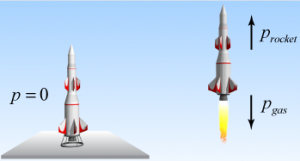In a rocket, the fuel burns and produces gases at high temperatures. These gases are ejected out of the rocket from a nozzle at backside of the rocket. The ejecting gas exerts a forward force on the rocket which helps it in accelerating. Suppose, a rocket together with its fuel has a mass M0 at t = 0. Let the gas be ejected at a constant rate r = – dM/dt. Also suppose, the gas is ejected at a constant rate r = – dM/dt. Also suppose, the gas is ejected at a constant velocity with respect to the rocket.
Suppose, a rocket together with its fuel has a mass M0 at t = 0. Let the gas be ejected at a constant rate r = – dM/dt. Also suppose, the gas is ejected at a constant rate r = – dM/dt. Also suppose, the gas is ejected at a constant velocity with respect to the rocket.
At time t, the mass of the rocket together with the remaining fuel is
M = M₀ – rt.
If the velocity of the rocket at time t is v, the linear momentum of this mass M is
P = Mv (M₀ – rt) v … 1
Consider a small time interval A mass Δm = rΔt of the gas is ejected in this time and the velocity of the rocket becomes v + Δv. The velocity of the gas with respect to ground is
\({{\vec{v}}_{gas,~ground}}=~{{\vec{v}}_{gas,~~rocket}}+~{{\vec{v}}_{rocket,~~ground}}\).
= – u + v
In the forward direction,
The linear momentum of the mass M at t + Δt is,
(M – ΔM) (v + Δv) + ΔM (v – u) … (2)
Assuming no external force on the rocket fuel system from (1) & (2),
(M – ΔM) (v + Δv) + ΔM (v – u) = Mv
Or,
(M – ΔM) (Δv) = (ΔM) u
Or,
\(\[\Delta v=\frac{\left( \Delta M \right)u}{M\Delta M}\).
Or,
\(\frac{\Delta v}{\Delta t}\text{=}\left( \frac{\Delta M}{\Delta t} \right)\text{ }\left( \frac{u}{M-\Delta M} \right)\text{ }=\text{ }\frac{ru}{M-r\Delta t}\).
Taking the limit as Δt →0,
\(\frac{dv}{dt}\text{=}\frac{ru}{M}\text{=}\frac{ru}{{{M}_{0}}-rt}\).
This gives the acceleration of the rocket. We see that the acceleration keeps on increasing as time passes. If the rocket starts at t = 0 and we neglect any external force such as gravity,
\(\int\limits_{0}^{v}{dv=ru\int\limits_{o}^{t}{\frac{dt}{{{M}_{0}}}}}-rt\).
Or,
\(v=ru\left( \frac{-\text{ }1}{r} \right)ln\frac{({{M}_{0}}-rt)}{{{M}_{0}}}\).
Or,
\(\)v=u\,ln\frac{({{M}_{0}}-rt)}{{{M}_{o}}}[/latex.
